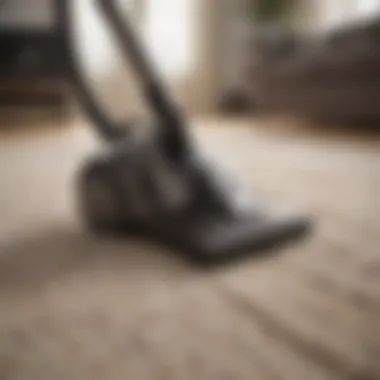Best Home Vacuum: Comprehensive Buying Guide


Intro
Choosing the ideal vacuum for your home is more than just making a purchase; it involves understanding your specific needs, preferences, and the various options available. Homeowners today face a plethora of choices in the vacuum market, including upright, canister, robotic, and handheld models. Each type offers unique features, making it crucial to discern which one aligns with your cleaning habits.
A well-chosen vacuum can significantly enhance home maintenance, contributing to a more hygienic living space. Good cleaning tools not only clean effectively but also make the process easier, reducing time and effort required from the user. This guide seeks to illuminate the different categories of vacuums, their functionalities, and how they can cater to individual lifestyles and homes.
Furthermore, we will explore the importance of design, practicality, and budget considerations. By analyzing user reviews and industry standards, this article will offer a detailed overview that can empower homeowners to make informed decisions.
Let’s begin with the design aspect of vacuums.
Understanding Home Vacuums
Understanding home vacuums is fundamental for anyone looking to maintain a clean and healthy living environment. This section will explore the definition and functionality of vacuums, as well as the important role they play in home maintenance. Selecting the right vacuum is not just about preferences, but also about the specific cleaning needs of your household. Having a clear grasp of these essential elements can save time and effort while ensuring effective cleaning performance.
Definition and Functionality
Home vacuums are devices designed to remove dirt, dust, and debris from different surfaces within a home. They typically operate using suction, a process that involves drawing in air and particles and capturing them in a bag or storage container. The core components include the motor, filtration system, and suction nozzle, which work together to provide efficient cleaning across various surfaces like carpets, hardwood floors, and upholstery.
Vacuums can vary significantly in design and purpose. For instance, upright vacuums often have robust suction and are ideal for larger areas, while handheld models focus on portability and quick cleanups. Robotic vacuums offer convenience through automated cleaning, but understanding their suction power and efficiency is important. Thus, knowing the definition and functionality of different vacuum types assists homeowners in making informed decisions when choosing a vacuum suitable for their unique requirements.
Importance of Vacuuming in Home Maintenance
Vacuuming is not merely a chore but a crucial aspect of home maintenance. Regular vacuuming plays a vital role in improving indoor air quality by reducing allergens like dust mites, pet dander, and molds. These allergens can cause respiratory problems and exacerbate conditions such as asthma.
In addition to health benefits, maintaining cleanliness contributes to the aesthetics and longevity of various surfaces. For example, carpets and rugs can get damaged if dirt is allowed to settle, potentially leading to costly replacements. Therefore, consistent vacuuming preserves both the look and lifespan of home furnishings.
"Regular vacuuming reflects not just cleanliness but also care for your living space."
In summary, understanding home vacuums is critical to selecting the right product that aligns with one's cleaning habits and household needs. A well-informed choice enhances both cleanliness and overall home comfort.
Types of Home Vacuums
Understanding the various types of home vacuums is critical for anyone looking to buy a suitable cleaning device. This section will delve into the distinct categories of vacuums, discussing their unique characteristics, advantages, and best-use scenarios. Each type has its own strengths, which can significantly affect cleaning efficiency and user experience.
Upright Vacuums
Upright vacuums are among the most popular styles on the market. They feature a convenient design with the motor and dust bag stationed above the floor head. One of the primary benefits of upright vacuums is their powerful suction capabilities, ideal for cleaning carpets and larger floor areas quickly.
These vacuums usually come with a variety of tools and settings, allowing users to adjust suction power for different surfaces. However, they might be less effective on stairs due to their bulkiness. Notably, newer models often include advanced filtration systems that cater to allergy sufferers, making them a suitable choice for households with pets or allergens.
Canister Vacuums
Canister vacuums provide versatility that many users appreciate. The design consists of a separate canister that houses the motor and dust collection, connected to a long hose. This setup allows for efficient cleaning of various surfaces, including hardwood, carpets, and upholstery.
One significant advantage of canister vacuums is their light weight, making them easier to maneuver in tight spaces. They are also commonly equipped with multiple attachments for specialized cleaning tasks. While some may require more storage space compared to upright models, their adaptability often makes them a preferred choice for thorough home cleaning.
Stick Vacuums
Stick vacuums represent a modern evolution in vacuum technology, blending convenience with performance. They are lightweight and usually cordless, which allows for easy navigation around the home. Their slim design can fit into areas that bulkier vacuums cannot, making them particularly handy for quick clean-ups and small spaces.


Most stick vacuums perform well on hard floors, but their suction power may vary on carpets. Some models come with a conversion feature, allowing for handheld use, which enhances their usability further. However, users should be aware that the battery life may limit longer cleaning sessions.
Robotic Vacuums
Robotic vacuums have gained popularity for their convenience, especially in busy households. These devices operate autonomously, using sensors to navigate through various floor layouts. Notable for their ability to run schedules, robotic vacuums can maintain cleanliness with minimal user intervention.
Although they may not provide deep cleaning on carpets like traditional vacuums, they are effective for regular maintenance, especially on hard floors. Advanced models can be controlled via smartphone apps and integrate with smart home systems. However, potential buyers need to consider their cleaning patterns, as robotic vacuums may struggle with cluttered environments.
Handheld Vacuums
Handheld vacuums are compact and designed for quick cleanups. They are lightweight and often battery-operated, making them an excellent choice for small messes and hard-to-reach places. Ideal for cleaning automotive interiors, stairs, or tight corners, their maneuverability is a clear advantage.
Although handheld vacuums lack the power of full-sized models, they can effectively tackle light debris and pet hair. User convenience is a significant aspect, as many models come with integrated tools for different cleaning needs. Depending on the requirements and frequency of use, they can serve as a helpful supplementary device in maintaining home cleanliness.
Employing an understanding of these types can markedly influence the purchasing decision, enhancing overall cleaning efficiency and home maintenance.
Key Features to Consider
When selecting a home vacuum, it is essential to focus on key features that define performance and usability. These features directly impact how effective the vacuum is at cleaning, which is especially important for homeowners looking to optimize their cleaning routines. In this section, we will discuss the critical attributes that should be kept in mind when evaluating a vacuum cleaner.
Suction Power
Suction power is arguably the most significant factor when assessing a vacuum. A powerful vacuum is able to pick up dirt, debris, and allergens more efficiently. This is crucial, particularly for those with pets or allergies. Evaluating the vacuum's wattage, airflow, and whether it has adjustable suction settings can reveal a lot about its performance. Consider the types of surfaces you will be cleaning; carpets, hard floors, and upholstery may require different levels of suction.
Filtration System
The filtration system in a vacuum can profoundly affect air quality in your home. High-efficiency particulate air (HEPA) filters are among the best options. These filters can trap particles as small as 0.3 microns. If allergies or respiratory issues are a concern, a vacuum equipped with a HEPA filter is highly recommended. Moreover, understanding how often the filter needs replacement or cleaning can also affect maintenance routines.
Capacity and Size
The capacity of a vacuum refers to the size of its dust bin or bag. A larger capacity means less frequent emptying, which can save time during cleaning sessions. However, a larger vacuum may be less convenient to store and maneuver. So, it is essential to find a balance that fits your cleaning needs and storage space. For example, individuals in small apartments might lean towards compact models, while houses with more floor space may benefit from larger capacity vacuums.
Weight and Maneuverability
The weight of a vacuum can greatly influence its usability. A lighter vacuum is easier to carry upstairs or from room to room. Additionally, the vacuum's design should allow for easy navigation around furniture and tight corners. Features such as swivel steering and integrated tools can enhance maneuverability. Evaluating these factors can lead to a more effective cleaning experience.
Noise Level
Lastly, noise level is another essential consideration. Some vacuums operate more quietly than others, which may be important for households with young children or individuals working from home. Look for products that specify noise level in decibels. Generally, a quieter vacuum is preferable but should not come at the cost of suction power. Evaluating noise levels can help you decide on a vacuum that maintains a peaceful home environment.
Considering these key features can guide you to a vacuum that meets your needs and enhances cleaning efficiency.
Evaluating Performance
Evaluating the performance of a home vacuum is critical for homeowners who seek efficiency and reliability in their cleaning efforts. A quality vacuum should not only remove dust and dirt but also enhance the overall home environment. Understanding performance requires looking deeper into various factors, such as user experiences, expert assessments, and real-world applicability.
Consumer Reviews and Ratings
Consumer reviews are vital to understanding the performance of vacuums. They provide insights from individuals who have used the products in their daily lives. These reviews often reveal how well a vacuum operates on different surfaces, such as carpets or hardwood floors. Additionally, they can highlight common issues, such as overheating or loss of suction, that may not be apparent in marketing materials.
When analyzing consumer ratings, it’s important to consider the context of the reviews. A vacuum may have a high rating, but if a significant number of users report problems with specific features, it could indicate a potential flaw. Homeowners should look for reviews that address long-term usage and real-life scenarios, which will give a more comprehensive picture of the vacuum’s reliability and effectiveness. Sites like Reddit and various home appliance forums are useful for gathering this kind of information.


Expert Comparisons and Tests
Expert comparisons are another essential element in evaluating vacuum performance. Industry professionals often conduct rigorous tests that measure suction power, noise levels, and overall durability. These tests are not influenced by personal experiences but rather assess the vacuum under controlled conditions.
Analyzing expert reports can provide a more objective view of a vacuum's capabilities. For instance, a vacuum might perform well in consumer reviews but could fall short during expert testing. Factors such as how well it handles pet hair or its efficiency in picking up allergens can affect overall ranking.
Many vacuum brands submit their products for testing by organizations like Consumer Reports. These tests are more reliable, as they often use standardized metrics to compare vacuums side by side.
Long-term Usage Reports
Long-term usage reports from users can provide valuable insights into a vacuum's longevity and performance over time. No product remains flawless indefinitely, and understanding how vacuums perform after extended use is crucial. Usually, consumers will address aspects like the need for maintenance, parts replacement, or changes in suction ability after several months.
These reports often reveal whether a product lives up to its claims or whether it becomes less effective as time goes by. A vacuum that starts strong may show signs of wear, which could lead to increased maintenance costs or diminished cleaning capabilities.
Overall, the evaluation of performance through the lenses of consumer reviews, expert comparisons, and long-term usage reports enables homeowners to make informed decisions. Taking these steps ensures that the chosen vacuum aligns with individual needs and contributes positively to home maintenance.
Budget Considerations
In the realm of selecting a home vacuum, budget considerations play a pivotal role. The price of a vacuum can greatly influence consumer choices, making it essential to understand various price ranges and what they entail in terms of quality, features, and overall value. Homeowners must strike a balance between affordability and functionality to ensure they invest in a vacuum that meets their cleaning needs without straining their finances.
Price Ranges of Different Types
When exploring the market, one will encounter a diverse spectrum of vacuum prices, often categorized by type. For instance, upright vacuums generally start around one hundred dollars and can exceed five hundred dollars for high-end models. Canister vacuums offer similar pricing ranges, but they often attract buyers looking for versatility.
Stick vacuums can range from seventy to four hundred dollars, depending on features like battery life and suction power. Robotic vacuums, on the other hand, might cost anywhere from two hundred to a thousand dollars, reflecting their technology and navigation capabilities. Handheld vacuums typically fall between thirty and two hundred dollars.
Cost vs. Features Analysis
Analyzing the relationship between cost and features is crucial for making an informed decision. Typically, lower-priced vacuums may lack advanced features present in pricier counterparts, such as powerful suction, HEPA filtration, or smart connectivity. If a consumer primarily seeks basic functionality, a budget vacuum may suffice. However, for those needing more comprehensive performance, investing in a mid-range to high-end model could yield better results and last longer.
It’s important to assess what features are fundamentally important. Do you require a vacuum that adapts to multiple surfaces or one that operates quietly? Evaluating these needs directly correlates with the expected cost.
Warranty and Customer Support
The warranty of a vacuum is a significant aspect of the overall value proposition. Generally, premium models come with longer warranties, reflecting manufacturer confidence in their product. Common warranty periods range from one to five years, covering various components and potential defects.
Customer support is also paramount. Simple access to support can alleviate concerns for users. Brands that provide robust customer service, accessible online resources, and responsive support will likely enhance user experience. Quality customer care can often justify a slightly higher price tag, ensuring that consumers feel supported throughout their ownership period.
Sustainability in Vacuum Design
In today's environmentally conscious world, sustainability in vacuum design has become a critical topic for many homeowners. As cleaning products are used more frequently, the ecological impact of these devices grows. Therefore, it is essential to consider how a vacuum's design can minimize harm to the environment while still maintaining functionality.
The right vacuum not only helps keep your space clean but can also contribute to a greener home. This section explores several key elements regarding sustainable vacuum design, discussing how eco-friendly features and energy efficiency ratings play a significant role in your purchasing decisions.
Eco-Friendly Features
When selecting a vacuum cleaner, eco-friendly features are high on the list of considerations. Modern vacuums now incorporate materials that are less harmful to the environment. For instance, some brands use recycled plastics in their construction, which reduces waste and conserves resources.
- Biodegradable Bags: Vacuum bags made from biodegradable materials break down over time, decreasing landfill contributions.
- Low VOC Emissions: Manufacturer initiatives to limit volatile organic compounds in vacuum design lead to cleaner indoor air, benefiting health and comfort.
- Sustainable Packaging: Many brands emphasize minimal and recyclable packaging to further reduce environmental impact.


These eco-friendly features not only appeal to environmentally aware consumers but also signal a company's commitment to sustainability. Thus, finding vacuums embedded with such features can set a precedent for responsible consumption.
Energy Efficiency Ratings
Energy efficiency plays a crucial role in evaluating the sustainability of vacuum cleaners. Using appliances that consume less energy helps reduce overall electric bills and limits greenhouse gas emissions. Many vacuums now come with energy efficiency ratings that indicate how much power they use for optimal performance.
- Standard Ratings: Look for Energy Star certifications. These vacuums meet energy consumption standards while still delivering high performance.
- Power Consumption: Analyzing the wattage can help you gauge how energy-efficient a model is. Lower wattage does not always equate to lower performance, so optimal designs can balance power and efficiency.
- Motor Technology: Advanced motor technology contributes to improved energy efficiency. Motors designed for reduced power consumption while providing strong suction make for a sustainable choice.
By focusing on energy efficiency ratings, homeowners can choose vacuums that not only clean well but also contribute to long-term energy savings and environmental health.
"A cleaner home can be a greener home. Adopting sustainable vacuums makes a difference."
Maintenance and Care
Maintenance and care are critical elements to consider when owning a vacuum. Neglecting these aspects can lead to reduced performance, increased wear, and a shorter lifespan for your device. Regular upkeep not only ensures optimal functionality but also enhances the efficiency of cleaning tasks around the home. A well-maintained vacuum cleaner can improve air quality by ensuring that dust, allergens, and other irritants are effectively captured and contained.
Understanding the specific maintenance requirements for each type of vacuum can guide users in creating a tailored care routine. Some vacuums may require more frequent cleaning of filters or brushes than others. Learning these nuances is essential for homeowners, as it maximizes their investment in their cleaning appliances.
Regular Cleaning Tasks
Regular cleaning tasks for your vacuum are essential to maintain its performance. Dust and debris can accumulate inside the vacuum, which affects its suction power. For upright and canister vacuums, check and empty the dust container or replace the bags regularly. Failing to do so can lead to blockages that hinder airflow.
Another key aspect of vacuum maintenance is the cleaning of filters. Most vacuums have washable filters that should be rinsed under warm water once a month, or as recommended by the manufacturer. It is also important to ensure that any rotating brushes are free of hair or tangles, as this can also affect their ability to clean effectively.
- Empty dust containers or bags regularly
- Clean or replace filters based on usage
- Remove hair and debris from brushes
Following these tasks allows for better suction and ensures your vacuum serves you longer.
Replacing Parts and Accessories
As with any appliance, parts and accessories of a vacuum will wear out over time. Regular inspection of these components can prevent serious issues before they arise. Filters and bags often need replacement after a certain usage period, depending on the model and type. Check your owner's manual for guidance on how often to replace these items.
In addition to filters and bags, there are other accessories, such as hoses and attachments, that may require replacement. These tools contribute to your vacuum's versatility, allowing you to clean various surfaces effectively. For example, a worn-out brush head may not pick up dirt efficiently, requiring you to replace it for optimal performance.
The benefits of keeping replacement parts on hand include:
- Ensuring consistent cleaning performance
- Extending the life of your vacuum
- Maintaining hygiene in your home
Taking the time to replace essential parts and accessories will pay off in the long run, enhancing the overall cleaning experience.
End and Recommendations
In any guide about home vacuums, a strong concluding section is crucial. It synthesizes the information and highlights recommendations based on the detailed analysis throughout the article. This section provides insightful takeaways that help readers solidify their understanding and empowers them to make informed choices. Homeowners often find themselves overwhelmed by the variety of options; thus, clarity in the final recap is essential.
Summary of Key Findings
Throughout the review of home vacuums, we explored various types, features, and performance evaluations. Each vacuum type—whether upright, canister, stick, robotic, or handheld—addresses different needs. Importantly, the following factors emerged as critical in choosing the right vacuum:
- Suction Power: Essential for effective cleaning across multiple surfaces.
- Filtration System: Important for maintaining air quality, particularly in homes with pets or allergies.
- Maneuverability: Weight and design impact how easily a vacuum can navigate your home.
- Noise Levels: Some homeowners may prioritize quieter options for less disruption.
These factors not only affect the cleaning capability of a vacuum but also influence the overall user experience.
"Selecting the right vacuum is not just about cleaning efficiency, but also about enhancing the quality of living spaces."
Top Picks for Various Needs
The ultimate choice of vacuum often depends on specific individual needs, such as lifestyle, home size, and personal preferences. The following models serve distinct purposes and stand out in their categories:
- For Heavy-Duty Cleaning: The Dyson Ball Animal 2 is revered for its powerful suction and advanced filtration, making it ideal for homes with pets.
- For Large Homes: The Miele Complete C3 is highly rated for its exceptional cleaning capacity and smooth maneuverability.
- For Quick Cleanups: The Shark Rocket Corded Hand Vac offers versatility. Its lightweight design makes it suitable for quick tasks without the hassle of a full-sized vacuum.
- For Tech Enthusiasts: The iRobot Roomba 980 provides autonomous cleaning capabilities, creating a modern solution for time-strapped homeowners.
- For Eco-Conscious Users: The Bissell EcoWave is designed with energy efficiency and eco-friendly materials, meeting sustainability preferences without compromising performance.
By evaluating these options, readers can make a choice that balances performance and their individual requirements.
This guide should serve as a reliable resource for homeowners looking to invest in a vacuum that complements their cleaning rituals while efficiently maintaining the home.















